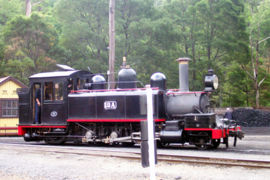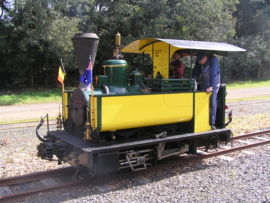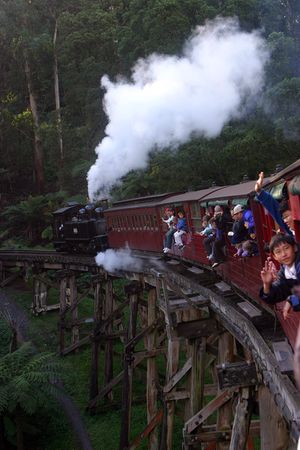Puffing Billy Railway, Melbourne
The Puffing Billy Railway is a narrow gauge 2 ft 6 in (762 mm) gauge heritage railway in the Dandenong Ranges near Melbourne, Australia.
| Melbourne's public transport | |||
|---|---|---|---|
| Metlink | Metcard | myki | |
| Modes of Transport | |||
| Trains | Trams | Buses | |
| Transport Routes | |||
| Railway stations | Tram routes | Bus routes | |
| Operating Companies | |||
| V/Line | Connex Melbourne | Yarra Trams | |
Contents
General
The railway was originally one of four experimental narrow gauge lines of the Victorian Railways opened around the beginning of the 20th century. It runs through the southern foothills of the Dandenong Ranges to Gembrook. Being close to the city of Melbourne and with a post-preservation history spanning over 50 years, the line is one of the best known preserved railways in the world, and attracts tourists from all over Australia and overseas.
The Puffing Billy Railway is kept in operation through the efforts of volunteers of the Puffing Billy Preservation Society, although intensive year-round operations necessitate a small band of paid employees to keep things going behind the scenes.
The railway aims to preserve the line as near as possible to how it was in the first three decades of its existence, but with particular emphasis on the early 1920s.
Operation
Operations are centred on Belgrave, which houses some of the offices of the railway (other offices are located at Emerald) and the locomotive sheds and locomotive workshops. It is also the base for track maintenance operations.
Most trains start from Belgrave and travel to Lakeside or to the terminus at Gembrook, and return. The railway operates every day of the year except Christmas Day, with at least two and up to six advertised services departing Belgrave each day. One service each day has the option of first-class carriages and lunch.
A semi-regular service is the Dinner Train, which usually departs Belgrave on a Friday or Saturday evening and travels to Nobelius Siding, where the passengers disembark and have a sit-down dinner in the converted packing shed of the former Nobelius Nursery. After the meal, the passengers rejoin the train for the return journey to Belgrave. Savouries and drinks are served on the train.
A popular feature of a ride on Puffing Billy is sitting on the ledge of the open-sided carriages (see picture).
Locomotives and rolling stock
See also: Victorian Railways
Locomotives

The railway owns every remaining narrow-gauge locomotive of the former Victorian Railways, and has restored to operating condition all except one, although not all are in serviceable condition at any one time. This fleet comprises five 2-6-2T restored and one unrestored NA class locomotives (3A is unrestored, while 6A, 7A, 8A, 12A and 14A are used), and one G class Garratt (G 42) locomotive and are restored, or being restored, to represent different eras in their development.
The railway also has a number of other steam locomotives from various sources, either on static display in its museum or in operating condition. These include a Peckett 0-4-0ST and Decauville 0-4-0T formerly from the West Melbourne Gasworks, and a Climax geared locomotive from the Tyers Valley Tramway. None of these locomotives are powerful or fast enough to operate on regular services, however they can occasionally be seen on special trains and at events such as Thomas the Tank Engine days.
Puffing Billy now offers driver experience days on the smaller steam engines. The Climax engine is being restored for this purpose as this engine has a commodious driving cab and is unique in Australia.
The railway also operates two diesel locomotives which are used on days of total fire ban, or when insufficient steam locomotives are available, including in emergencies. The diesel locomotives originally operated on railways in Tasmania and Queensland, and were regauged for use on the Puffing Billy Railway.
Carriages
The mainstay of the carriage fleet are the 15 NBH open-sided carriages built specially for tourist traffic on the Gembrook line by the VR between 1918 and 1919, and further vehicles built to similar design in the preservation era. However, there are also a number of enclosed carriages, both saloon and compartment cars. In addition, four carriages were obtained from the Mount Lyell Railway in Tasmania after its closure in 1963, and regauged for Puffing Billy use. These vehicles are now used as first-class carriages and used primarily on the Luncheon train and Dinner train.
Several carriages have been temporarily converted to include a guard's compartment. A number of NQR low-sided goods wagons have also been modified for passenger use, making them similar to the NBH carriages. Another NQR wagon has been fitted with seats but no roof and is only used during the summer peak season.
Goods vehicles and brake vans
Representatives of all classes of goods vehicles and brake vans (including combined brake van and passenger carriage) used on the narrow gauge lines of the Victorian Railways are to be found on the Puffing Billy line, and are used for works trains, storage, and occasional heritage trains recreating the look of trains in the 1920s.
Structure
Puffing Billy Preservation Society
When the Puffing Billy Preservation Society was formed in 1955, the line was under the control and ownership of the Victorian Railways (VR). The Society arranged for the VR to run the train on weekends and holidays, with the Society guaranteeing the VR against losses from insufficient ticket sales. Society volunteers took the role of conductors, checking tickets on the train, and fund-raising. This arrangement continued until the Upper Ferntree Gully to Belgrave section was closed in 1958.
When the line reopened in 1962 (between Belgrave and Menzies Creek), Society volunteers took a larger role, manning stations, selling and checking tickets, and doing non-safety-critical maintenance on the train, and track maintenance under the supervision of a VR ganger. Ticket revenue went into an account on which the VR drew to pay for their staff involved in running the line.
Emerald Tourist Railway Board
The Victorian Railways were not in the preservation business, and the arrangement was less than ideal, so in 1977 the Victorian Government passed the Emerald Tourist Railway Act 1977 (No. 9020) to set up the Emerald Tourist Railway Board as a statutory authority to take over ownership and operation of the railway from the VR. The Act requires that the Board have between five and ten members, four of which are to be nominated by the Puffing Billy Preservation Society. Successive governments have had sufficient confidence in the Board that they have never appointed their full entitlement, effectively leaving control of the Board in the hands of Society nominees.
With the Board, volunteers were now able to take on more responsible roles, including filling the positions of signalmen, guards, and firemen, and later drivers, although the Board does employ staff drivers to provide the core of the driving tasks. All volunteers filling responsible positions are required to undergo training and testing in their responsibilities.
History
Pre-preservation
The line was opened in 1900 to serve the local farming and timber community. It originally ran from Upper Ferntree Gully station, the terminus of the broad gauge line from Melbourne and now part of Melbourne's suburban railway system, but it now begins at Belgrave.
The train, known to the locals as "Puffing Billy" amongst other names, stopped running in 1953 after a landslide blocked the line between Selby and Menzies Creek, and it was formally closed in 1954. Today the former line between Upper Ferntree Gully and Belgrave is serviced by Connex suburban electric trains, while the line beyond Belgrave has been reopened by the Puffing Billy Preservation Society.
Post-preservation
Following closure, a few "farewell specials" operated on the remaining usable section to Belgrave, which proved very popular. On 1 October 1955, the Puffing Billy Preservation Society was formed to keep the train running indefinitely. This continued until 1958 when the line to Belgrave was closed for conversion to a broad-gauge, electrified suburban line. The society then started work on restoring the Belgrave to Lakeside section, and in 1962, restored train operation between Belgrave and Menzies Creek.
Subsequently operations were gradually extended over the remainder of the original line to Emerald in 1965 and Lakeside in 1975 before reaching Gembrook, which was completed in 1998, and reopened on October 19 of that year. Today the railway operates daily (except for Christmas day) as a popular tourist activity over 15 miles (24km) with original steam engines, and is operated with some of the railway practices from the Victorian Railways 1900 to 1930 era, such as using the "Staff and Ticket" safeworking method and having conductors on board the trains.
Volunteers
Without the input of hundreds of volunteers who put themselves on rosters for a wide range of duties, the line would not be economical. Although there are also paid staff involved in maintaining the train and its line, performing support roles such as accounting and advertising, and providing the backbone of the driving duties, volunteers are involved in almost all aspects of running the train including manning stations, selling tickets, maintaining the track and trains, and driving and safeworking duties. Many of these roles involve being trained for positions of responsibility.
List of stations
Regular Puffing Billy services stop only at stations shown in bold print below.
- Belgrave, adjacent to the suburban station of the same name.
- Selby
- Menzies Creek
- Clematis
- Emerald
- Nobelius Siding
- Nobelius
- Lakeside (Emerald Lake)
- Wright
- Cockatoo
- Fielder
- Gembrook


